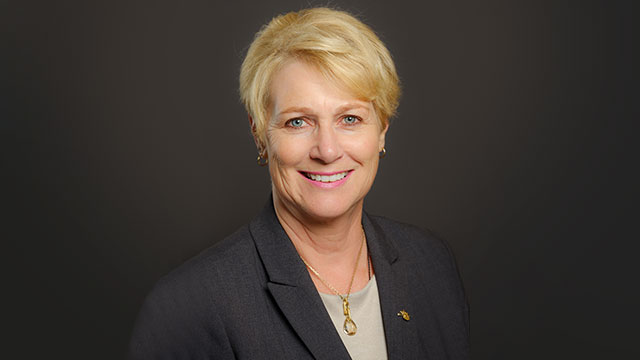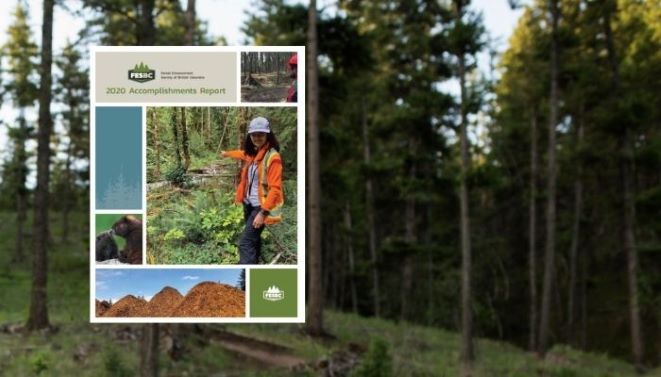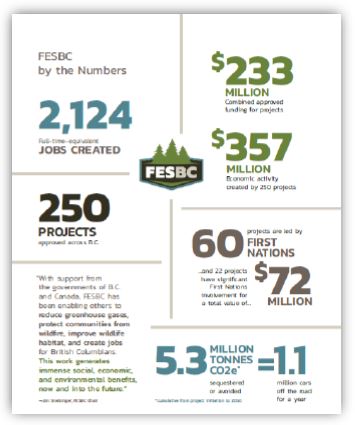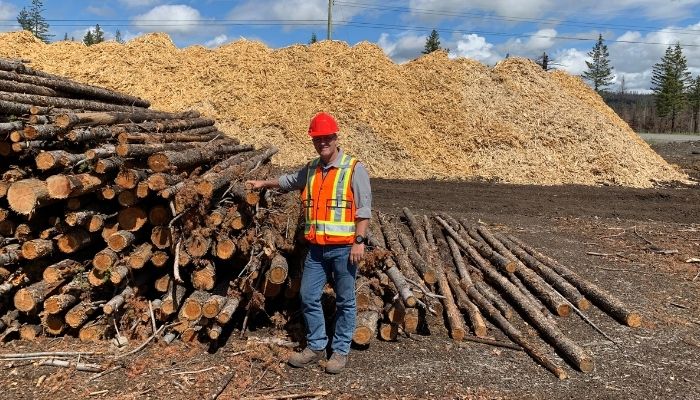VICTORIA – The Forest Enhancement Society of BC (FESBC) has allocated $3 million in new grants throughout the province to support jobs in the forestry sector and increase the use of wood fibre that otherwise would be burned as slash.
“This new funding is part of the government’s $1.5 billion economic recovery plan, which reflects our ongoing commitment to help British Columbians deal with challenges posed by the COVID-19 pandemic,” said Katrine Conroy, Minister of Forests, Lands, Natural Resource Operations and Rural Development.
“The grants will support local jobs and help make better use of wood debris left behind after timber harvesting.”
Katrine Conroy, Minister of Forests, Lands, Natural Resource Operations and Rural Development
The latest round of funding supports 15 different projects in different regions of the province, with individual grant amounts ranging from $6,000 to $663,748 (see backgrounder for details about each project). The projects will allow about 250,000 cubic metres of post-harvest waste wood to be used in the production of pulp, wood pellets, electricity and compost for soil remediation. This work will also provide environmental, economic and social benefits to B.C. communities, including a reduction in greenhouse gases.
“One of the aims of our StrongerBC economic recovery plan is to build stronger, more resilient communities in every corner of the province,” said Ravi Kahlon, Minister of Jobs, Economic Recovery and Innovation. “This program does just that, while also advancing the forest sector’s transition to high-value production, which is essential for B.C.’s long-term economic wellbeing.”
Eight of the approved applications were from new proponents that will receive FESBC project funding for the first time.
“We were very pleased to receive this additional funding to support incremental fibre use and forest rehabilitation projects,” said Jim Snetsinger, board chair, FESBC. “Upon receiving word of the $3 million allocation, our team moved quickly to prepare and announce its seventh intake for funding applications.”
“We were delighted with the quality and innovation shown in the proposals that we received. This work will help support families and communities in a time of need. It demonstrates the significant role that the forestry sector plays in our province’s broader economic recovery, while at the same time helping to achieve B.C.’s and Canada’s climate change targets.”
Contacts:
Aleece Laird
Communications Liaison
Forest Enhancement Society of BC
communications@fesbc.ca
250 574-0221
Ministry of Forests, Lands, Natural Resource Operations and Rural Development
Media Relations
250 213-8172
Connect with the Province of B.C. at: http://news.gov.bc.ca/connect
Facts about FESBC
The Forest Enhancement Society of BC (FESBC) is a Crown agency. It was established in 2016 to advance the environmental and resource stewardship of the province’s forests by:
- preventing wildfires and mitigating wildfire impacts;
- improving damaged or low-value forests;
- improving wildlife habitat;
- supporting the use of fibre from damaged or low-value forests; and
- treating forests to improve the management of greenhouse gases.
As of Jan. 28, 2021, the B.C. government has invested $238 million in FESBC, with about $237 million allocated to 270 projects since the society’s inception. Funded projects have helped minimize wildfire risks, enhance wildlife habitat, improve low-value and damaged forests, replant damaged forests and use fibre for green-energy production.
FESBC is a partner in the Forest Carbon Initiative, which is funded in part through the federal government’s Low Carbon Economy Leadership Fund. This initiative assists with B.C. government priorities, such as:
- revitalizing the forest sector;
- partnering with First Nations;
- supporting the Province’s CleanBC commitment to transition to a low-carbon economy; and
- providing economic benefits for rural communities.
$3 million in grants support fibre use projects
The Forest Enhancement Society of BC has allocated another $3 million in grants to support 15 projects that will increase the use of wood fibre that otherwise would have been burned as slash.
Funding for these projects has been distributed as follows:
October 2020 project approvals (Intake #7):
- $20,000 to Interwest Timber Ltd. to take uneconomical pulp fibre to a plant for chipping and future delivery to coastal pulp mills (about 1,537 cubic metres in the south coast region)
- $101,562 to the Village of Fraser Lake for the Fraser Lake Community Forest, to transport uneconomic residual waste fibre to the Pinnacle Pellet plant in Burns Lake (about 13,488 cubic metres in the Omineca region)
- $135,000 to Cariboo Pulp & Paper to transport low-value pulp fibre, which otherwise would be uneconomical to move, to manufacture pulp (about 9,122 cubic metres in the Cariboo region)
- $200,000 to Atlantic Power (Williams Lake) Ltd. to help local First Nations companies deliver fibre to Atlantic Power for electricity generation (about 15,385 cubic metres in the Cariboo region)
- $663,748 to Arrow Transportation Systems Inc. to transport uneconomic fibre to secondary users (about 44,250 cubic metres in the Thompson-Okanagan region)
- $216,158 to Westland Resources Limited to enhance use of uneconomic pulp logs from two licensees (about 22,125 cubic metres in the Skeena region)
- $279,749 to NorthPac Forestry Group Ltd. to increase fibre use by sending residual waste to coastal pulp mills (about 18,355 cubic metres in the Skeena region)
- $6,000 to Westwood Fibre Resources Ltd. to increase use of residual waste fibre for distribution to secondary fibre users in the southern Interior (about 660 cubic metres in the Thompson-Okanagan region)
- $133,745 to Pinnacle Renewable Energy Inc. to increase fibre use by manufacturing wood pellets (about 45,803 cubic metres at various locations across the province)
- $336,252 to East Fraser Fiber to distribute waste fibre to a local chipping plant and other secondary fibre users in the north-central Interior (about 15,913 cubic metres in the Omineca region)
- $300,000 to Duz Cho Logging Limited Partnership to increase fibre use by manufacturing wood pellets (about 15,625 cubic metres in the northeast region)
- $61,750 to Husby Forest Products to recover otherwise uneconomic fibre from timber harvesting operations and support coastal pulp mills (about 4,060 cubic metres in the West Coast region)
- $326,533 to Valley Carriers Ltd. to increase use of wood waste, which will be ground up for use in energy production (about 30,432 cubic metres in the Okanagan Shuswap District)
- $83,100 to ?Elhdaqox Developments Ltd. to use waste fibre from a tree stand rehabilitation project for energy or wood pellet production (about 10,000 cubic metres in the Cariboo Chilcotin District)
- $136,403 to Tk͛emlupsemc Forestry Development Corporation to convert woody biomass into a growth medium that expedites plant growth and soil stabilization (about 5,940 cubic metres in the Thompson-Okanagan Region)
See the FESBC Projects page for a map of all projects: https://www.fesbc.ca/projects/




